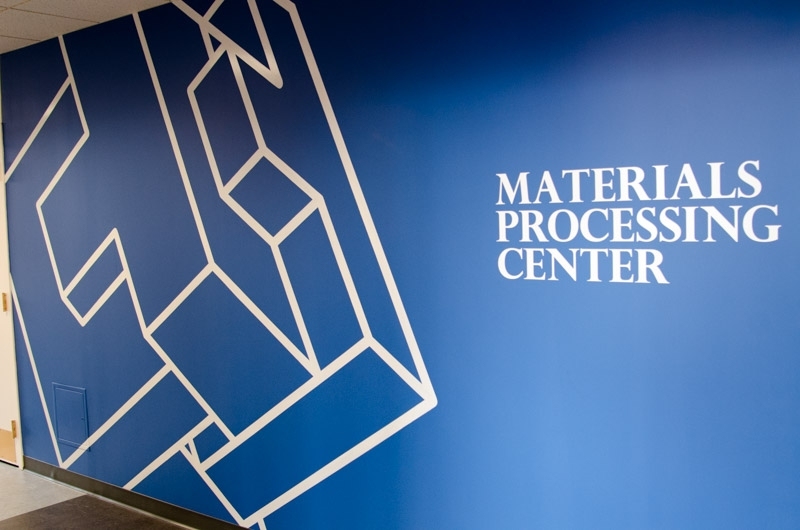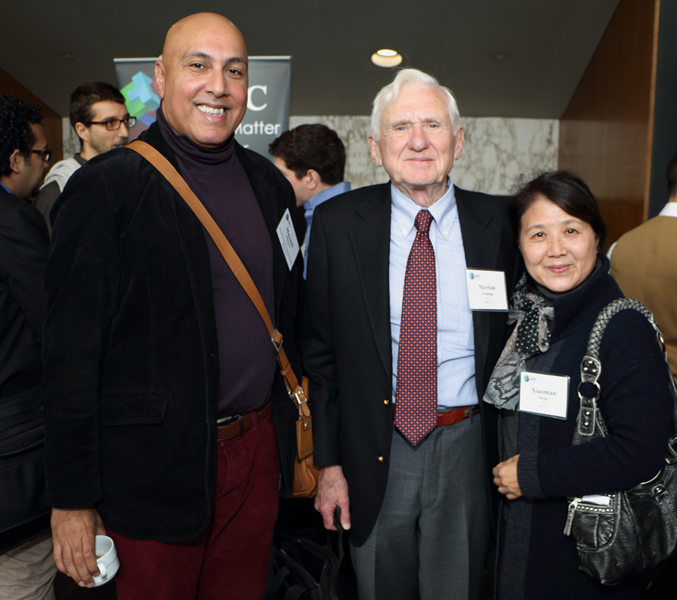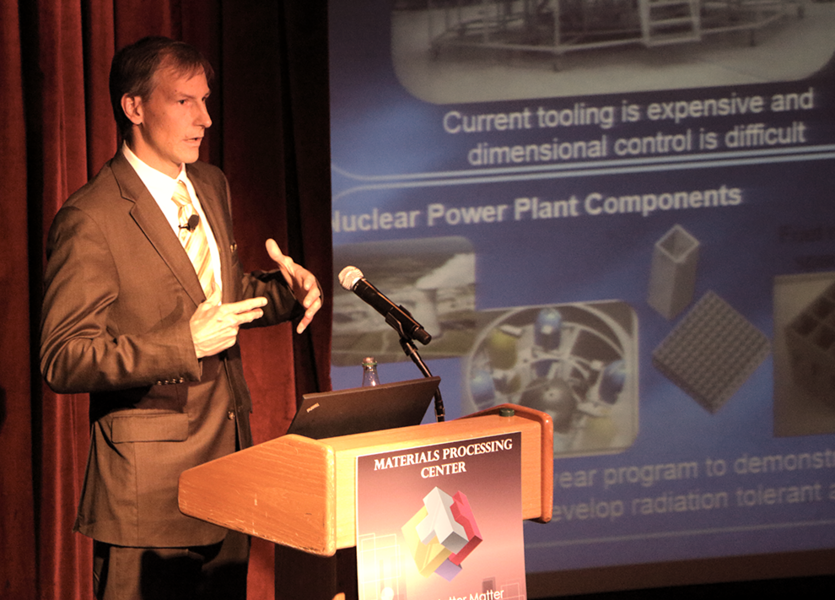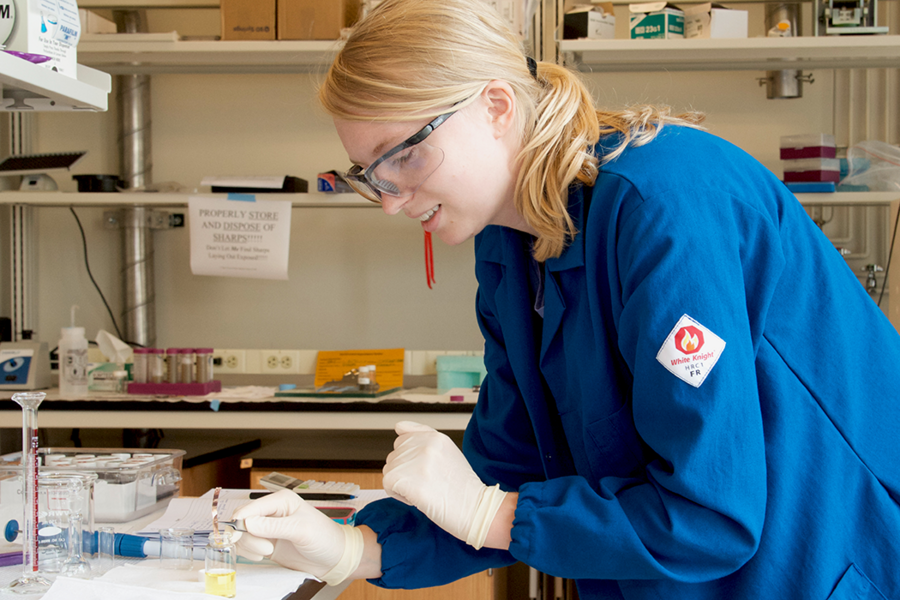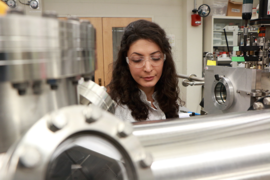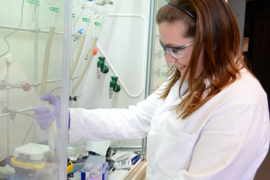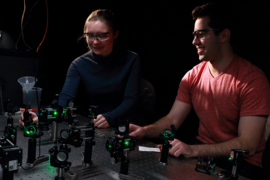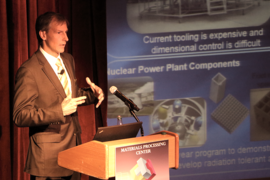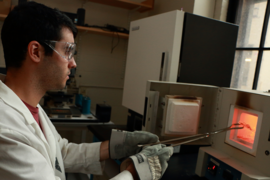The Materials Processing Center (MPC) celebrates 35 years of service to the MIT faculty and materials research community during 2015. Current MPC research topics include synthesis of materials for optoelectronics, microphotonics, solar and thermal energy, biomedicine, microelectronics, and quantum computing, building on its original foundation of metallurgy, polymers, composites, and ceramics.
"The original foundation areas remain just as relevant for research, as tools for nanostructuring are allowing us to revisit the same materials to address the challenges facing people today and in the future," says MPC Associate Director Mark Beals. "Studies of materials at the nanoscale reveal new insights into fundamental properties of materials."
As an interdisciplinary center within MIT’s School of Engineering, MPC serves about 60 researchers in both the School of Engineering and the School of Science, assists in drafting proposals and administering grants, and provides industrial outreach and communications. The MPC also helps faculty to organize interdisciplinary teams for large grants, new initiatives, and development of new centers.
Serving his seventh year as MPC’s director, Carl V. Thompson sees the MPC as playing a critical role in supporting and developing an integrated interdisciplinary approach to materials research. “The buildings we live in, the cars we drive, the smartphones that connect us to the world, everything, is made of materials. There have been tremendous advances in our ability to design, synthesize, and discover new materials, and this is driving the evolution of existing technologies and spawning new ones. New principles and new ideas come from many places within the Institute, not from just one department or one school. The MPC provides a commons for students, faculty, and staff to share ideas and to develop shared goals, and to reach outside the Institute to share their vision with industry, government, and the public.” The actual 35th anniversary date was Feb. 1.
Merton Flemings, founding director of MPC and retired Toyota Professor of Materials Processing at MIT, recalls the Materials Processing Center arose in 1980 in response to a need to make American industry more competitive and bring the focus back to civilian industry as the Cold War was winding down. NASA was an important early MPC funder focusing on materials for use in space. “I had this idea that we should move beyond this focus on pure science and beyond military research to look at the processing side of materials science and engineering and to focus on civilian industries,” Flemings says.
“While I was only head of the Materials Processing Center for two years, it’s been a great pleasure for me to watch how over these past 35 years, so many faculty members have collaborated together to develop new materials, to synthesize materials, to combine materials in new ways, to develop devices that would not have been possible without advanced processing of materials, and generally to contribute to the field in important and significant ways. Today, the work the Materials Processing Center is doing is even more important than it was in the past years as I see the kind of inventive, innovative, creative and useful research that continues to emanate from the laboratory and its faculty and students. What is particularly exciting for me is to see the MPC today not only collaborating with industry but spawning new companies and industries," Flemings says.
Today, MPC-affiliated researchers are working on projects to design and implement energy-storage systems that go beyond the capabilities of lithium-ion batteries, achieve the scientific understanding and develop the materials that will enable quantum computing, and lay the groundwork for integrated microphotonic systems. Research volume was $16 million during fiscal year 2013-14.
Centers affiliated with MPC include the Skoltech Center for Electrochemical Energy Storage, which is led by Professor Carl V. Thompson, and the Microphotonics Center, which is led by Professor Lionel Kimerling. MIT researchers affiliated with the multi-university Center for Integrated Quantum Materials also rely on MPC for administrative work; MIT Department of Physics Professor Raymond Ashoori is a co-principal investigator on the project. Professor Harry L. Tuller’s Chemomechanics of Far-From-Equilibrium Interfaces (COFFEI) research project aims to produce better oxide-based semiconductor materials for fuel cells.
The MPC Industry Collegium links member companies to materials research. MPC also works closely with the MIT Industrial Liaison Program (ILP) to provide expertise to companies with materials-related needs. The MPC director and associate director, in collaboration with the ILP, travel internationally providing seminars highlighting research by MPC’s faculty and meet with members of MPC’s Industry Collegium and interested businesses and universities. Significant events have been held in Stuttgart, Germany; Tokyo, Japan; Bangkok, Thailand; and Taipei, Taiwan.
MPC’s external advisory board helps set policy and direction for research. Together, the collegium and external advisory board provide contacts with industry for MPC faculty, research collaborations, and financial support.
MPC hosts the daylong Materials Day Symposium and poster session each October on the MIT campus, drawing about 150 attendees and 75 poster presentations. In conjunction with the Center for Materials Science and Engineering, MPC also administers the annual Summer Scholars program, which brings some of the most talented undergraduate science students in the U.S. and Puerto Rico to MIT for nine weeks of research each summer.
Other programs for which MPC manages funds include:
- Professor Donald Sadoway’s continuing research on liquid metal batteries, which is being commercialized by Ambri;
- Assistant Professor Antoine Allanore’s effort to develop potassium fertilizer from feldspar as an alternative source to potash (Brazilian mining company Terrativa is funding the research);
- SMART Low Energy Electronic Systems, a thrust within the Singapore MIT Alliance program, which is led by Eugene A. Fitzgerald, the Merton C. Flemings-SMA Professor of Materials Science and Engineering at MIT;
- Professor Michael Cima’s Convergence Products Research Lab (formerly Ceramics Processing Research Lab); and
- the MIT Glass Lab, which is administratively co-sponsored by the Materials Processing Center and the Department of Materials Science and Engineering.
MPC does not have laboratory space of its own; rather, it supports faculty members in managing laboratory facilities where they are principal investigators. The Substrate Engineering Lab located in Building 13 is one example.
In support of the Institute's plans for building the new MIT.nano facility on the site of Building 12, MPC headquarters and staff moved to new offices on the fifth floor of Building 24 in June 2014.
